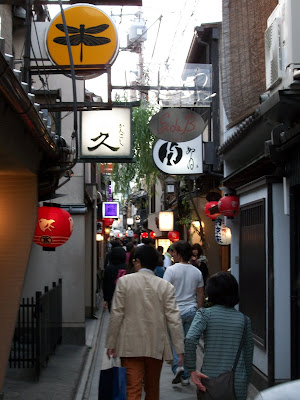Japan Trip - Kyoto Day 1 - Pontocho
>> Wednesday, May 26, 2010

We're back from Japan! We went to lots of amazing places, saw lots of incredible things, and took lots of great pictures. Internet access was scant the last week or so of our trip, so we have a lot of catching up to do. Let's return to Kyoto, Japan's beautiful former capital, and explore Pontocho, one of the few surviving geisha districts in Japan.
A block west of Kamagawa (the Kama River) runs a long, narrow alley that is home to dozens, if not hundreds, of tea houses, restaurants, and bars--as well as some of the last remaining geisha houses in Japan.
Side streets offer glimpses of the Kamagawa, which has a long, sandy walking path along it. In the summer months, the restaurants and bars along the Kamagawa side offer outdoor seating on patios over the canal there in the foreground. We saw people out there one night, but it was too dark and my pictures didn't turn out. It was a charming area though, with running water, the soft sounds of laughter and conversation, and glowing lanterns that swayed in the riverside breeze.
It's not hard to imagine this place two hundred, three hundred, four hundred years ago, with samurai and geisha in kimono walking along the river. (Geisha have been practicing their arts in Pontocho since at least 1500.)
The small corridor retains a great deal of charm, even as it has become more modern. Nowhere else in Kyoto did we find this kind of atmosphere, and we walked up and down this street multiple times, savoring it. The street is too narrow for car traffic, and just busy enough with pedestrians to feel really alive. There was an electricity, a liveliness to the place that we couldn't get enough of.
A rare lonely moment on Pontocho.
Lanterns announcing food or entertainment within still hang outside many of the establishments, but what really struck us about the place was its mystery. The main drag of Pontocho has a great deal of character, but the entrances to the tea houses and restaurants and bars themselves are tucked far back off the street down smaller side alleys, as though they are secret places.
They certainly did feel secret, and inaccessible. In the same way that Shibuya felt hidden to me, Pontocho's real heart was hidden away from the tourists and strollers--as it probably has been for five hundred years.
This entrance way was filled with orchids. Deliveries from admirers to a geisha house?
What lies beyond?
Of course, what all the tourists--Japanese and gaijin alike--are there hoping to see are the geisha, who pop out of the few remaining geisha houses and hurry along to their appointments.
The first time a real geisha came out of a house in front of us and hurried away, it was magical. They are exquisitely dressed and carefully made up, every attention paid to the details of their overall look. Never a hair or sash or robe out of place.
The literal translation of geisha into English is "artist," or perhaps "performance artist," and indeed geisha are trained from a very young age to dance, sing, play music, write poetry, and use calligraphy. There was certainly a sexual element to the careers of geisha as well, but over time there came to be a clear delineation between geisha and prostitute, with the geisha life focusing more and more on entertainment of the more modest variety. It's complicated, but today geisha are strictly entertainers.
The geisha we saw in Ponotcho do not like to be photographed--or at least, have no intention of stopping for, or acknowledging, photographers. I would have thought that gaijin (outsiders) like me would be the worst for geisha paparazzi, but in fact it was the Japanese who were the worst, hurrying along in front of the traveling geisha with massive cameras and flashes, snapping shot after shot after shot. I tried to be more modest about my picture taking, trying to respect the women's privacy while reluctantly acknowledging their very public and very exotic roles as well. I caught this geisha as she popped out of her house and hurried down to the end of Pontocho.
To our surprise, she, like this geisha, got into a waiting taxi!
And sped off like a celebrity, to the snapping cameras of Japanese onlookers.
Later, we caught a geisha and her maiko (apprentice geisha) heading off for an engagement.
They move quickly, and have a (practiced?) knack for turning their heads away when a camera appears.
That the geisha still exist is itself something of a marvel. Girls used to be sold into this life, and were essentially indentured servants until they could repay their masters the money spent on them, from purchase to feeding to clothing to training. Today, women must choose to be geisha, and fewer and fewer are choosing that lifestyle. In the 1920s, there were more than 80,000 geisha in Japan. Today, there are an estimated 1,000-2,000 real geisha in Japan. We were thrilled and awed to catch a glimpse of what is left of "the flower and willow world."





































2 comments:
Gorgeous geishas. Their shoes always strike me as the scariest thing about their outfits - it's not enough to be wrapped up in yards of silk - here! Stand on blocks of wood! And don't fall off!
I really think Kyoto is the best part of the whole trip. Love the lanterns.
What a fantastic trip - that first photograph is stunning. I've spent one day in Kyoto and long to go back - and actually, maybe it's lucky you arrived by coach - it took us 3/4 hour to get out of the station, with no signs (that we could read) towards an exit anywhere!
Post a Comment